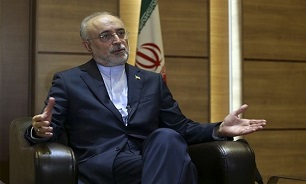Trump on loser’s side, won’t benefit from JCPOA withdrawal
 The remarks by Ali Akbar Salehi, who also serves as a vice president to President Hassan Rouhani, come as Iran and other signatories to the Joint Comprehensive Plan of Action (JCPOA) try to salvage the accord, now challenged by US President Donald Trump.
The remarks by Ali Akbar Salehi, who also serves as a vice president to President Hassan Rouhani, come as Iran and other signatories to the Joint Comprehensive Plan of Action (JCPOA) try to salvage the accord, now challenged by US President Donald Trump.
Salehi sought to contrast Iran’s behavior, which includes abiding by the atomic deal, against “emotional and sensational moves.”
“I think [Trump] is on the loser’s side because he is pursuing the logic of power,” Salehi told the Associated Press in an exclusive interview in Tehran. “He thinks that he can, you know, continue for some time but certainly I do not think he will benefit from this withdrawal, certainly not.”
The US withdrawal from the Iran deal and the return of US sanctions already has affected Iran’s economy, crashing its rial currency. Further sanctions coming in November threaten Iran’s oil industry, a major source of government funding.
Salehi heads the Atomic Energy Organization of Iran, whose Tehran campus encompasses a nuclear research reactor given to the country by the US in 1967, under the rule of the former shah.
Iran has long said its nuclear program is for peaceful purposes, but it faced years of sanctions due to Western concerns. The 2015 nuclear deal Iran struck with world powers, including the US under former president Barack Obama, was aimed at relieving those concerns.
Under it, Iran agreed to store its excess centrifuges at its underground Natanz enrichment facility under constant surveillance by the United Nations’ nuclear watchdog, the International Atomic Energy Agency. Iran can use 5,060 older-model IR-1 centrifuges at Natanz, but only to enrich uranium up to 3.67 percent.
That low-level enrichment means the uranium can be used to fuel a civilian reactor. Iran also can possess no more than 300 kilograms (660 pounds) of that uranium. That’s compared to the 100,000 kilograms (220,460 pounds) of higher-enriched uranium it once had.
Salehi spoke about Iran’s efforts to build a new facility at Natanz that will produce more advanced centrifuges, which enrich uranium by rapidly spinning uranium hexafluoride gas..
For now, the nuclear accord limits Iran to using a limited number of an older model, called IR-1s. The new facility will allow it to build advanced versions called the IR-2M, IR-4 and IR-6. The IR-2M and the IR-4 can enrich uranium five times faster than an IR-1, while the IR-6 can do it 10 times faster, Salehi said.
“This does not mean that we are going to produce these centrifuges now. This is just a preparation,” he said. “In case Iran decides to start producing such centrifuges in mass production, we would be ready for that.”
Salehi suggested that if the nuclear deal fell apart, Iran would react in stages. He suggested one step may be uranium enrichment going to “20 percent because this is our need.” He also suggested Iran could increase its stockpile of enriched uranium.
In the wake of Trump’s decision, Western companies from airplane manufacturers to oil firms have pulled out of Iran. Iran’s rial currency, which traded before the decision at 36,000 to $1, now stands at about 140,000 to $1.
Despite that, Salehi said Iran could withstand the economic pressure, as well as restart uranium enrichment with far more sophisticated equipment.
“If we have to go back and withdraw from the nuclear deal, we certainly will not go back to where we were before,” Salehi said. “We will be standing on a much, much higher position.”
Message end/
